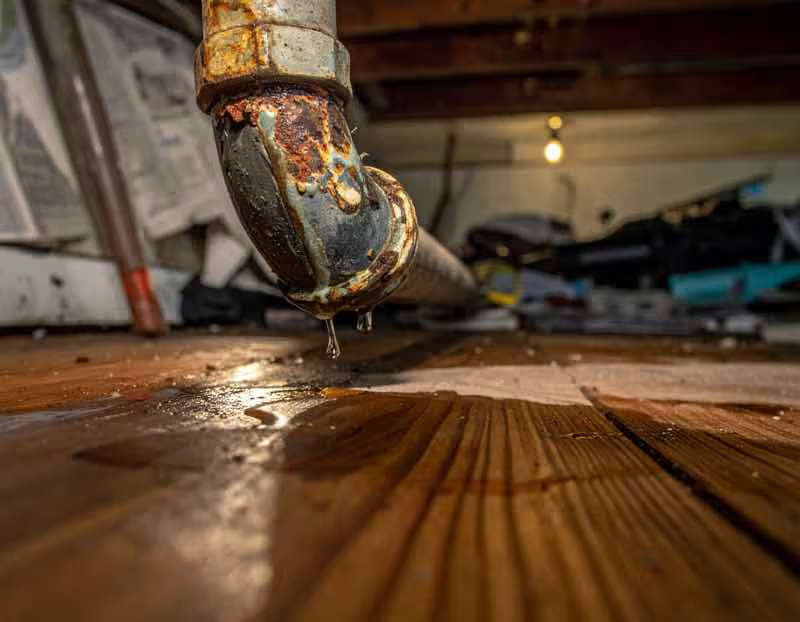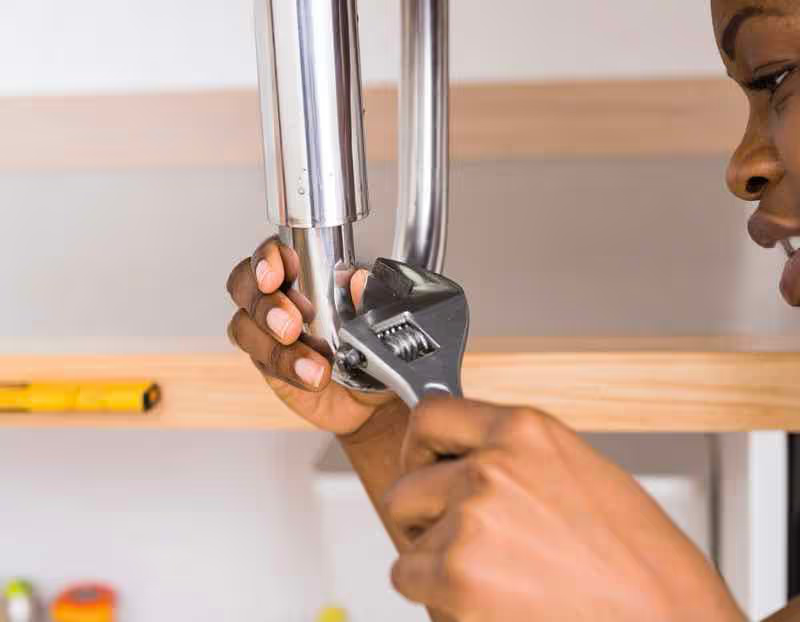Can Temporary Sealants Fix Leaking Pipes? (When DIY Works & When to Call a Plumber)
Temporary sealants can fix minor pipe leaks for 24-72 hours, but many situations require immediate professional help. Learn when DIY is safe vs. risky.
Free Estimate

You're standing in your kitchen at 11 PM watching water drip from under the sink, and the hardware store doesn't open until morning. Can a temporary sealant actually stop the leak, or are you just delaying the inevitable call to a plumber? According to insurance industry data, the average water damage claim costs $11,650, and many start with homeowners trying temporary fixes that fail.
This guide explains exactly when temporary sealants can fix leaking pipes, which products work for different leak types, and when you need a plumber immediately to avoid thousands in water damage. We'll cover how pipe sealants actually work, compare the most common products (including Flex Seal), show you when DIY is reasonable, and explain the red flags that mean you need professional help within hours, not days.
How Temporary Pipe Sealants Actually Work (And Their Limitations)
Temporary pipe sealants create physical barriers through epoxy or putty compounds, or they form compression seals using specialized tape. However, these products cannot restore the structural integrity of your damaged pipe. They cover the problem temporarily but don't fix the underlying issue.
Water pressure, pipe material, and leak location determine whether a sealant will work. A pinhole leak in an accessible copper pipe responds differently than a crack in a PVC joint under constant pressure. Temperature changes and normal pipe movement cause most temporary fixes to fail within 72 hours, even when applied correctly.
Sealants fail consistently on threaded connections because the turning motion required for proper installation breaks the seal. They also fail on corroded pipes where the metal continues deteriorating beneath the patch. Pressurized water lines push against sealants with constant force, eventually finding weak spots in your temporary barrier.
After years of fixing failed DIY attempts, we see homeowners waste money on products that simply cannot work for their specific leak type. A $15 tube of epoxy won't fix a problem that requires cutting out and replacing a corroded pipe section.
Need help with a leak that isn't responding to sealant? Call Brightwater Plumbing at (407) 307-1625 for emergency pipe repair in Orlando.
Can temporary sealants fix leaking pipes?

Temporary sealants can fix minor leaking pipes for 24–72 hours in emergency situations, but they're not permanent solutions. Epoxy putty works best for pinhole leaks in accessible pipes, while rubber tape is effective for compression joints. However, sealants cannot fix burst pipes, corrosion damage, leaks inside walls, or failing threaded connections. If you see water staining walls, hear rushing water, or notice pressure loss, call a plumber immediately—temporary fixes will fail and cause expensive water damage. For accessible, minor leaks, sealants buy time until professional repair.
Need same-day pipe repair in Orlando? Call Brightwater Plumbing at (407) 307-1625 – available 24/7 for emergency service.
Temporary Sealant Products Compared: What Works for Different Leaks
Epoxy putty works best for pinhole leaks in copper or PVC pipes where you can access the entire damaged section. You can expect 48–72 hours of hold time before the seal begins failing. Apply it only to straight pipe runs where movement stays minimal during the curing period.
Rubber repair tape creates compression around joints and works for temporary hose repairs. When applied correctly with 50% overlap and proper tension, it lasts 24–48 hours. The tape must stretch to 75% of its capacity during application or the seal won't hold against water pressure.
Flex Seal spray works on slow seeps in non-pressurized applications only. Despite marketing claims, it's not recommended for active household plumbing under normal water pressure. The spray coating lacks the thickness and structural support needed for pressurized pipe systems.
Pipe clamps with rubber gaskets provide the most reliable temporary fix for straight-run pipe leaks. When properly positioned and tightened, they can last weeks with regular monitoring. The metal clamp distributes pressure evenly, preventing the gasket from shifting or deteriorating quickly.
Plumber's tape and silicone caulk don't work for active leaks, despite common misconceptions. Plumber's tape (thread seal tape) only works on dry, threaded connections during assembly. Silicone requires a completely dry surface and 24 hours to cure, making it useless for emergency leak situations.
Can You Fix a Leaking Pipe Without a Plumber? (The Honest Assessment)
DIY is reasonable when you have an accessible pipe with a minor leak that drips rather than streams. You must be able to shut off the water completely and dry the area before applying any sealant. This approach works when you need to buy 24–48 hours until you can schedule professional repair.
DIY becomes dangerous for leaks behind walls, under slabs, near electrical systems, or in ceiling spaces. You cannot properly assess damage you cannot see. Hidden leaks spread water through building materials, creating problems far beyond the original leak location.
Water behind walls causes mold growth within 24–48 hours according to CDC guidelines on mold prevention. Once mold starts growing in drywall or insulation, you're facing remediation costs that dwarf the original repair expense. The humid Orlando climate accelerates this timeline even further.

Consider the real cost comparison: a $15 sealant that fails versus a $150–300 service call versus $2,500+ for water damage remediation. The cheapest option upfront often becomes the most expensive when temporary fixes fail and cause secondary damage.
We typically see homeowners succeed with DIY on garden hose connections and exterior faucets. We almost never see successful DIY repairs on supply line leaks, especially those serving fixtures inside the home. The pressure difference makes these situations fundamentally different.
Not sure if your leak is DIY-safe? Call Brightwater Plumbing at (407) 307-1625 for a free phone assessment, or visit our pipe repair services page.
Step-by-Step: Applying Temporary Sealant Correctly
Shut off the water at the fixture valve or main supply line. This critical first step prevents water pressure from interfering with your repair. Drain the line by opening the lowest faucet in your system. Dry the pipe completely using towels and a hairdryer if necessary. Most temporary fixes fail because homeowners skip this drying step or don't shut off water completely.
Surface preparation determines seal quality. Lightly sand the damaged area with fine-grit sandpaper to remove oxidation and create texture for epoxy adhesion. Clean away all dust, debris, and remaining moisture before applying any product.
For epoxy putty application: Knead equal parts of the two-component putty until the color becomes uniform. You have 3–5 minutes of working time before it begins hardening. Press the putty firmly around the leak, extending at least one inch beyond the damaged area in all directions. Build thickness to at least 1/4 inch for adequate strength. Allow the full curing time specified on the package before restoring water pressure.
For rubber tape: Start wrapping two inches before the leak location. Pull the tape to 75% of its maximum stretch—it should feel resistant but not break. Overlap each wrap by 50% of the tape width. Continue wrapping two inches past the leak. Secure the end by pressing firmly and allowing the self-fusing properties to bond.
Testing your repair: Turn water back on slowly, increasing pressure gradually over 2–3 minutes. Watch for any seepage around the repair. Check again after 15 minutes and once more after one hour. If you see any moisture during testing, shut off water immediately and call a professional.
We see most DIY fixes fail because homeowners restart water flow before the surface is completely dry or before epoxy has cured. Rushing this process guarantees failure.
When Temporary Fixes Become Expensive Mistakes
Call a plumber immediately if you see water staining on drywall, ceiling leaks, or your water meter spinning with all fixtures turned off. These signs indicate active leaks spreading through your home's structure. Loss of water pressure or audible rushing water inside walls means the problem extends beyond what you can see or reach.
Hidden leaks reveal themselves through indirect indicators. A persistent mold smell, warped flooring, or unexplained increases in your water bill all point to leaks you cannot access. Warm spots on concrete floors suggest hot water lines leaking under your slab foundation.
Wall leaks always require professional intervention. We use specialized detection equipment including thermal imaging and acoustic sensors to locate the exact leak position. Accessing these leaks requires cutting drywall strategically to minimize repair costs. We also assess adjacent areas for water damage that isn't visible from the outside.
Most homeowner insurance policies exclude coverage for "gradual damage" resulting from maintenance neglect or failed DIY attempts. They cover sudden pipe failures but not damage that accumulated over days or weeks while you tried temporary fixes. This distinction can cost you thousands in uncovered repairs.
Follow the 24-hour rule: if your temporary fix fails within the first day, professional diagnosis reveals a larger underlying problem 90% of the time. The leak you see is often just one symptom of broader pipe deterioration, corrosion, or installation defects.
What Does Professional Pipe Repair Actually Cost? (And What You Get)

Service call pricing in Orlando ranges from $89–150 for diagnostic visits. Many plumbing companies waive this fee when you proceed with the recommended repair. You pay for the plumber's expertise in identifying not just the visible leak but underlying causes.
Common repair costs break down by complexity: pinhole leak repairs run $150–300, pipe section replacement costs $200–500, and leak detection services range from $200–400. These prices include labor, materials, and code-compliant installation that passes inspection.
Professional repair includes proper diagnosis using testing equipment homeowners don't own. You get code-compliant work that meets Florida building standards. The warranty on completed work protects you if problems emerge after installation. Most importantly, professionals prevent secondary damage by controlling water exposure during repairs.
Compare repair costs against consequences: the average water damage insurance claim costs $11,650. Mold remediation alone runs $2,000–6,000 depending on the affected area size. A ceiling collapse from prolonged leak exposure can exceed $10,000 in structural repairs and replacement of damaged belongings.
Professional plumbers also identify related issues during repairs. We find corroded pipe sections that would fail within months, improper installations from previous homeowners, and system-wide problems that temporary fixes cannot address.
See detailed pricing for pipe repairs in Orlando by calling Brightwater Plumbing at (407) 307-1625 for upfront quotes.
Next Steps: Making the Right Call for Your Situation
Use temporary sealant if: You have an accessible pipe with a minor leak, you need 24–48 hours to schedule repair, the leak location is completely visible, and you can monitor it continuously. This approach works for buying time, not replacing professional repair.
Call a plumber within 2 hours if: You cannot access the leak source, you see water staining or ceiling damage, you notice pressure loss throughout your system, or your temporary fix attempt failed. These situations worsen rapidly and create compounding damage with every passing hour.
Make an emergency call right now if: You have active flooding, leaks near electrical panels or outlets, your water meter won't stop spinning, or you see structural damage like sagging ceilings or buckling floors. These situations threaten your safety and your home's structural integrity.
Prepare for the plumber's visit by shutting off water at the main if you can do so safely. Document the leak location with photos showing the surrounding area. Clear access to the affected space by moving furniture, stored items, or anything blocking the work area. This preparation speeds up diagnosis and reduces your labor costs.
Need pipe repair in Orlando? Call Brightwater Plumbing at (407) 307-1625 for same-day service. We provide upfront pricing, licensed plumbers, and emergency availability 24/7. Visit our Google Business Profile or see our complete pipe repair services.
Get a Free Quote!
Terms and Conditions
Request a Quote
Terms and Conditions
Request a Quote
Terms and Conditions


